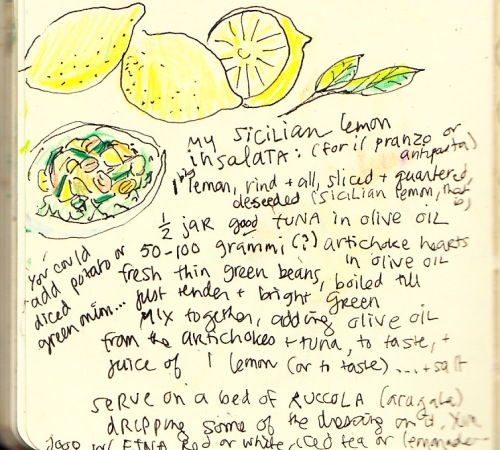Wow. I didn’t know very much about antipasto until last weekend when I was invited to an antipasto-making day with friends. I was visiting Cathy in California, and she and her dear friend Meg had organized this event with Christina, an Italian-American cook and singer. The idea was to make a big batch of antipasto and can it for holiday gifts and eating.
The timing was perfect. After all, in Italian, antipasto literally means “before the meal” (anti coming from the Latin ante, before, as in our word anticipation), so what better time to focus on the starters than shortly before that great feast of Thanksgiving?
Cathy filled me in on the basics: This was a grand antipasto of marinated vegetables and tuna, for special occasions. The recipe had been passed down from her Swiss-Italian family and her aunt Alice made it to serve on Christmas.

Aunt Alice's recipe
Christina also had an aunt (Mimi) who excelled at making the antipasto. Her family recipe came from the Le Marche region of Italy. It was also a special-occasion antipasto and was served at the wedding feast of her grandparents on September 25, 1911 — nearly 100 years ago.

Two batches of vegetables are brined overnight
The two recipes were remarkably similar in both ingredients and methods. Cathy and Meg had done a test run the weekend before and came up with a method combining the two.
We started the night before, cutting up vegetables. Celery, carrots, cauliflower and green beans, went in one pot; pearl onions, red peppers and cucumbers in the other, and each had a different mixture of salt water brine to soak in overnight.

We drained and rinsed the veggies in the morning.

Meg and Christina discuss the best way to do this.

Now, artichokes, button mushrooms, capers, and green and black olives are added to the mix.

The whole mixture is cooked briefly in olive oil, vinegar, and tomato sauce, with a sprinkling of herbs.



Filling the jars with the marinated vegetables and sauce
Because we were canning these jars for a long shelf life, for food safety reasons we decided to buck tradition, and leave the tuna out, making this a vegetarian (vegan, really!) version. The tuna could be added once the jar is opened, before the antipasto is served.

Removing the jars after 15 minutes of the boiling water bath

Three happy cooks
But that wasn’t all —there were more good things to come! Namely, lunch (il pranzo), and more specifically, Christina’s fabulous gnocchi, prefaced by her gnocchi song and a demonstration. (I should have video, or at least audio here — maybe a link will be forthcoming, if someone else makes it.)
By the way, if you’re wondering how to say “gnocchi,” click here.
 Christina made the dough with russet potatoes boiled in salted water till fork-tender, then cooled and peeled. Then she mounded up some flour on the work table, riced the potatoes (with a ricer) into squiggly shapes right into the mound of flour and bit by bit incorporated the flour into the potatoes, sprinkling with some salt. Next, she drizzled beaten egg yolks over the mixture and gently shaped into a loaf, being careful not to overwork the dough.
Christina made the dough with russet potatoes boiled in salted water till fork-tender, then cooled and peeled. Then she mounded up some flour on the work table, riced the potatoes (with a ricer) into squiggly shapes right into the mound of flour and bit by bit incorporated the flour into the potatoes, sprinkling with some salt. Next, she drizzled beaten egg yolks over the mixture and gently shaped into a loaf, being careful not to overwork the dough.
The ratio: 2 pounds of raw potatoes, 2 cups all purpose flour, 2 egg yolks and salt to taste.

She rolled pieces of the dough into ropes, then cut them into bite-size gnocchi, pressed lightly with the tines of a fork. And we all rolled ropes and cut the pieces along with her.

Boil till they float right up and taste done!

Sauced with some delicious pesto....

And eaten outside in a beautiful garden -- if you're lucky enough to be in California!
Well, back in the cold and gray Northwest, I still have a warm glow from the pleasure of cooking and eating with friends–as well as carrying on and adapting Old World traditions.
It was a lovely preface to Thanksgiving, and as befits that holiday, I am feeling full of gratitude. Thank you Cathy, Meg and Christina–and happy Thanksgiving to all you readers, friends, cooks, and appreciative diners —
Toby



















